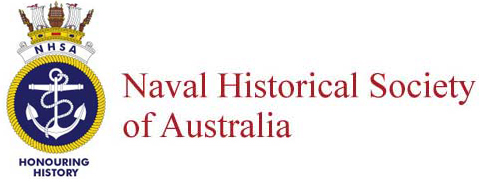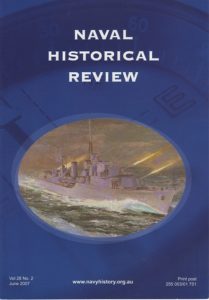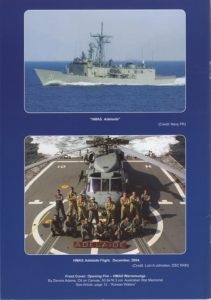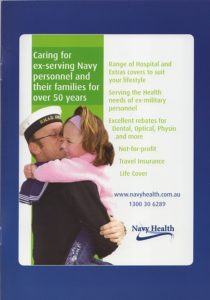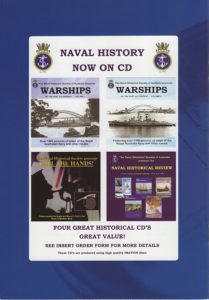- Author
- A.N. Other
- Subjects
- History - general
- Tags
-
- RAN Ships
- None noted.
- Publication
- June 2024 edition of the Naval Historical Review (all rights reserved)
By Murray Davies
The Challenge
My initial thought was, ‘Well, this should be easy…’ I collect swords and I usually do a fair amount of background research on them when they come home. I particularly like it when I can find the original owner’s name. It is even better when I can find their picture and get some of the backstory. When this sword came up at auction in mid-2023 it rather unusually had a photograph of the owner with it (figure 1). The sword was an 1827 Pattern Naval Officer’s sword and the photo was marked ‘NSW Naval Brigade’ (figure 2). Armed with what I thought was a pretty good head start, I set off on my research.
Hoping for a quick win, I ran the picture through a reverse search engine. Unfortunately, all that came up was a series of American Civil War generals! Early days, so I backed up and started with the attribution to the ‘NSW Naval Brigade.’ I must confess as an ex-Army officer I had never heard of the NSW Naval Brigade so I spent some time there first. The unit was formed in 1863 as events in Europe had caused many of the separate Australian colonies to think of their self-defence needs1. It was not ship-based and they were not marines but rather an infantry-like force that deployed from ships, armed with small arms and light artillery. To make matters a little more confusing NSW also boasted a New South Wales Marine Corps, a Naval Artillery Volunteers and Naval Light Infantry2. The NSW Naval Brigade only existed until 1902 when Australia’s defence was unified under the new Federal Government. The Brigade did deploy to China to aid the British in the Boxer Rebellion.
Help!
Having exhausted my first round of research I reached out to both the Australian War Memorial and the Naval Historical Society of Australia for help. Both organisations were incredibly helpful. The Naval Historical Society of Australia, and in particular, Walter Burroughs and Drs John Haken and John McGrath, provided me with considerable information including details on uniforms and potential identities.
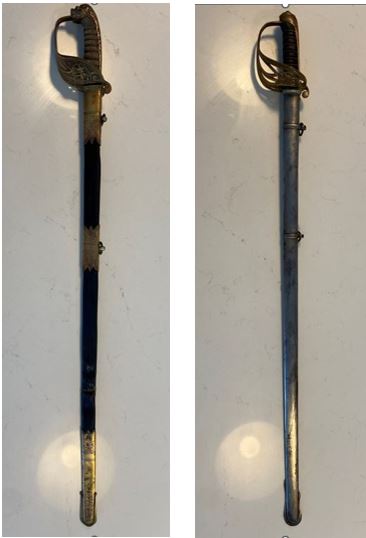
Figure 2 (right): 1825 -1845 British Army Officer’s Sword – author’s collection
I was able to trace these people and was able to find a couple of pictures. Unfortunately, when I compared thesepictures to the fellow in my picture using facial recognition software they did not match (the ears were all wrong). Digging deeper, I went to the NSW Archives and sourced the NSW Public Service List for 1893.3 The Blue Book, as it was also known, listed all the officers of the Naval Brigade including eight Sub-Lieutenants. Two of these I had already discounted and I started to research the remaining six but had no joy placing my man.
The Name is…
At this point, I stopped and decided to go back to the source, the photograph. The front of the photograph could provide no further clues so I had a much closer look at the back. I was hoping to find a photographer’s name or studio. No luck there but under much stronger magnification and different light I did find in very faint pencil writing that said ‘Rolfe Original.’ Sub Lieutenant John Rolfe was one of the six names I was looking at. He was the Gunnery Master for the Brigade and had served in China.
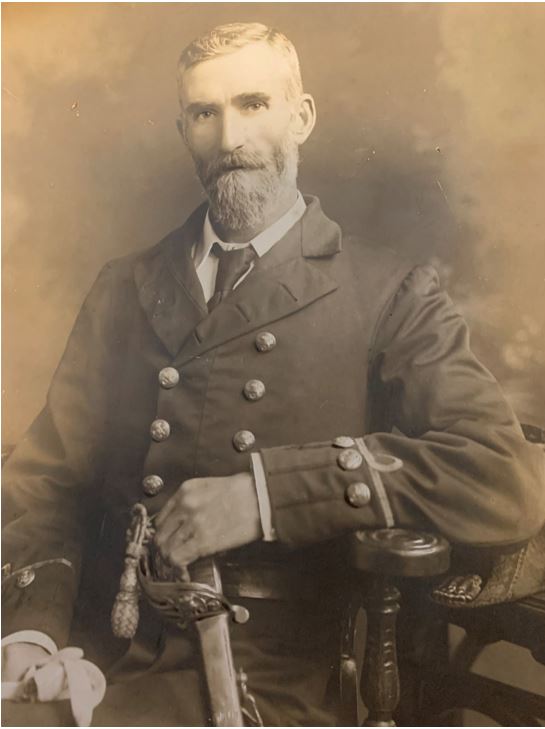
The Wrong Sword
There is one other curious thing about this photograph. The sword in the photo and the sword that accompanied it are not the same. The sword that accompanied the picture is an 1827 Royal Navy officer’s sword. There are no markings, numbers or dates on the blade and it is probably a mid-level quality sword.
As John McGrath had pointed out to me, the sword in the picture is an 1825-45 Pattern Infantry Officers’ sword with steel scabbard. I have one like it in my collection (figure 3). So, why is a Navy Officer carrying an Army infantry sword?
Curiously, when I looked around at pictures of Naval Brigade officers in this period and particularly in China, they all seemed to be carrying the same sword. I have no evidence to support this but my sense is that this was a deliberate choice. The 1827 was a sword largely designed to mark the individual’s status as an officer and may have been somewhat useful in close-quarter engagements on ships. It was not a ‘fighting sword’ as such and for what was essentially a land-based force like the Naval Brigade would not have been appropriate. The 1825-45 was longer and heavier and would have seemed better suited to combat on land. I do believe that Sub Lieutenant Rolfe owned the 1827 pattern I now have and this was used for more formal/ceremonial occasions.
Lessons Re-learned
Yes, I was rather arrogant to assume that this one would be ‘easy’. No two historical problems are ever the same. What I re-learned from this was to look at historical problems from all angles and dimensions. Use the facts and data, study the artefacts and look at both sides of the picture. Also, there are a lot of people out there smarter than me who have specific domain knowledge. Reaching out to people and groups like the Australian War Memorial and the Naval Historical Society of Australia is a great way to boost your research efforts.
These lessons are important to remember when you are researching the lives of people who have served our country. The swords are unremarkable; the NSW Naval Brigade only existed for just over 40 years and only fought in one small engagement. Despite this, Sub-Lieutenant John Rolfe served and that needs to be remembered correctly and his service celebrated.
References
1 Haken, J.K. (2007). The New South Wales Naval Forces 1863 – 1902. https://navyhistory.au/the-new-south-wales-naval-forces-1863-1902.
2 Creighton, K. (18 April 1986). Our First Military Adventure in Asia. Royal Australian Navy News. Vol. 29, No. 7. p. 8.
3 NSW Public Service List for 1893. Open Government NSW. https://www.opengov.nsw.gov.au/publications/13912
